Renowned worldwide as the “father of medicine,” Hippocrates was born in Kos around 460BC. It was he who freed the art of healing from the magical-religious conceptions of the past, rejecting the belief in the divine source of disease. Hippocrates studied medicine at the famous Asclepieion on the island and, influenced by the wealth and efficacy of the local herbs, he developed a deep faith in the healing power of Mother Nature.
Thanks to an abundance of water, the island of Kos is verdant, and a varied landscape means that its plant life is rich and diverse. The vast expanses of sandy beach, interspersed with rocky, precipitous coastline, the deep ravines, the wetlands, both coastal and inland, and the fertile plains, all provide habitats for more than a thousand species and subspecies of plants. It’s an impressive number in relation to the island’s size.
Hippocrates used approximately 250 of Kos’s plants to treat ailments and diseases, many of which still grow on the island. Although he lists plants without descriptions (he assumed that his contemporary colleagues and herbalists would be familiar with them), it is not difficult to identify the majority. However, much care and knowledge is required to trace the survival of his influence through the still alive, but somewhat neglected, tradition of folk medicine.
Below, is a selection of plants found on Kos that were once used by Hippocrates and remain important to folk medicine to this day. By rubbing their branches and their trunks, or crushing their leaves to release their aromas, one can begin to get a sense of their medicinal properties. This is precisely how, centuries ago, people such as Hippocrates could, with careful observation, a love for their fellow human and an understanding of balance and harmony, release their patients from pain and disease.
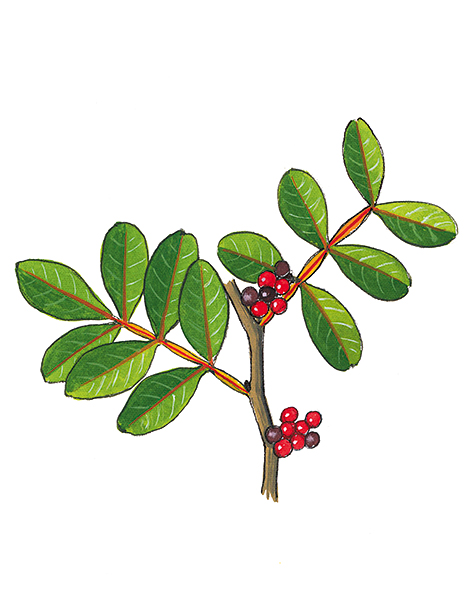
© Illustration: George Sfikas
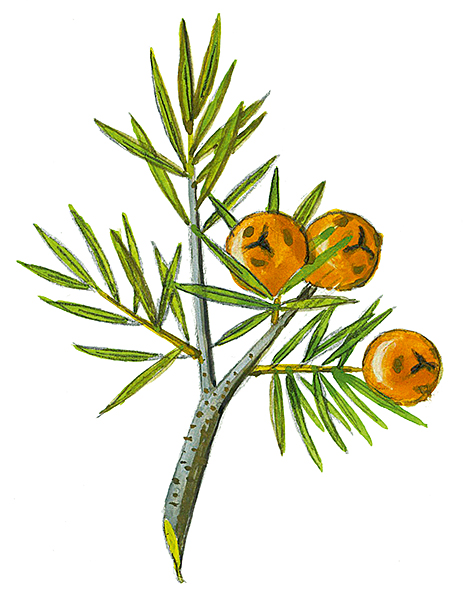
© Illustration: George Sfikas
Lentisk Bush
Pistacia lentiscus
An evergreen shrub that loves sunny spots, it is found on rocky slopes and pine forests on the island, usually not far from the sea. Hippocrates used its leaves and resin for the treatment of many gynecological complaints. Later, the seeds of the shrub were pounded to make an oil for the treatment of a variety of skin conditions. Today, traditional Aegean medicine still makes use of its bark for healing wounds.
Large-Fruited Juniper
Juniperus macrocarpa
A shrub or small tree no taller than five meters, it is usually found self-seeded on sandy beaches. Its leaves resemble sharp needles, while its fleshy, spherical berries are deliciously aromatic. Hippocrates used the berries of all the plants of the genus Juniperus in preparations for relieving pain and reducing the chills after childbirth, and for treating “hysteria.” Today, in many areas of the Mediterranean to which it is native, the plant’s black, ripe fruits are harvested and turned into a decoction which is applied to the skin as an antiseptic and disinfectant.
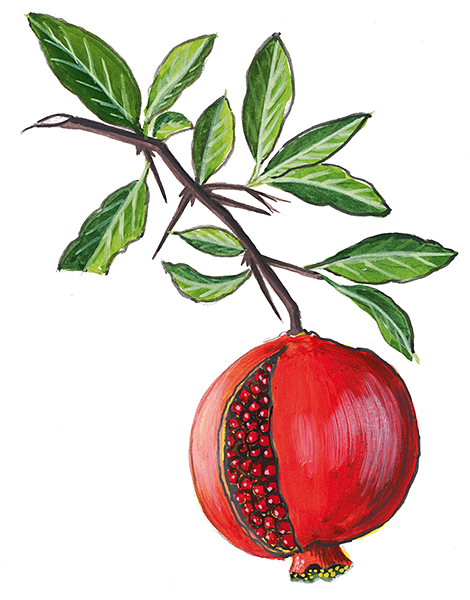
© Illustration: George Sfikas
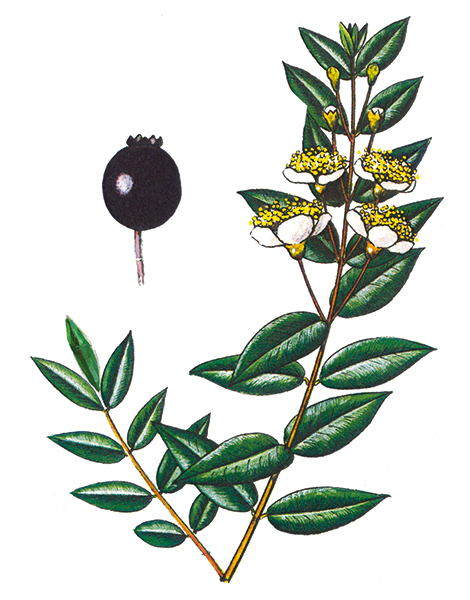
© Illustration: George Sfikas
Pomegranate
Punica granatum
Every spring, this plant steals the show in the gardens where it grows with its bright red flowers. By autumn the flowers have transformed into one of the real jewels of the plant kingdom, the pomegranate. Their use in the therapeutic arts goes back to antiquity, and in the Hippocratic Corpus we find many references to the uses of its leaves, flowers, fruit and roots for many medical complaints. A large part of this knowledge survives in the islands’ traditional herbal medicine: the flowers are used to fight inflammation, the rind of the fruit is employed against diarrhea and intestinal parasites, and the juice is used to detoxify the body.
Myrtle
Myrtus communis
A beautiful evergreen shrub, myrtle grows on the banks of wetlands or on damp ground. In antiquity, the plant was linked to the goddess Aphrodite, because legend had it that she hid behind a myrtle bush when she emerged from the waves. Because of this connection, women in ancient Greece bathed in water in which myrtle leaves and berries had been soaked in order to preserve their youth, and Hippocrates recommends that water for personal feminine hygiene. Folk doctors use an astringent lotion made from the leaves for skin conditions as well as a wine enriched with the juice of the black berries to ease stomach aches.
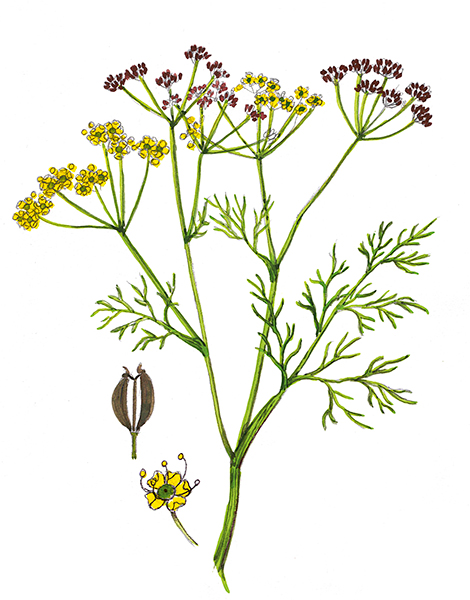
© Illustration: George Sfikas
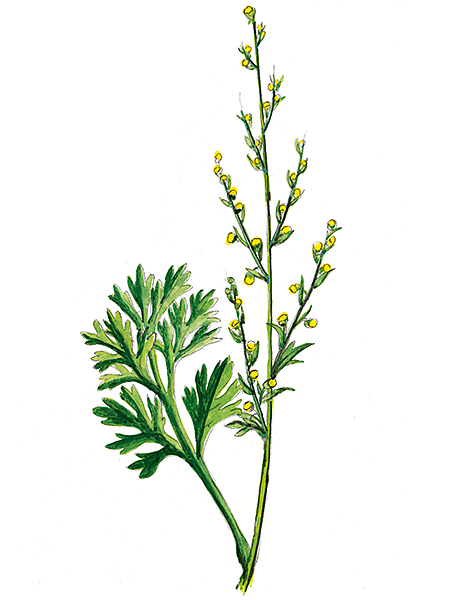
© Illustration: George Sfikas
Fennel
Foeniculum vulgare
It is not hard to spot wild fennel in clearings and fields on the island: it is a tall, aromatic plant, which stands out thanks to its silky fronds. According to Hippocrates, it is useful for stimulating lactation in nursing mothers as well as for easing menstrual discomfort. The ancient reputation of its seeds for helping lactation persists to the present day, while its use is also widespread for the treatment of indigestion, gastric wind, coughs and lung phlegm.
Wormwood
Artemisia absinthium
A perennial herbaceous plant reaching a height of up to one meter, it is found growing in meadows and fallow fields. It is an aromatic and very bitter herb, which Hippocrates recommends against jaundice and tetanus as well as for stimulating menstruation. It makes an exceptionally bitter tea, and it takes real courage to drink a cup of it. However, its therapeutic powers are so strong that it never lost its ancient reputation as a cure for indigestion, gastritis, intestinal parasites and many more, mainly peptic, ailments.
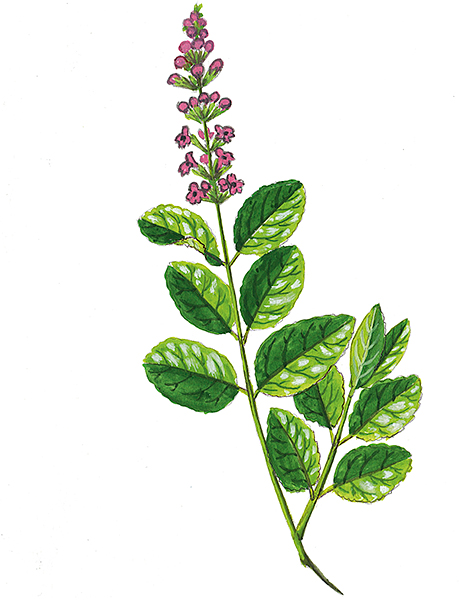
© Illustration: George Sfikas
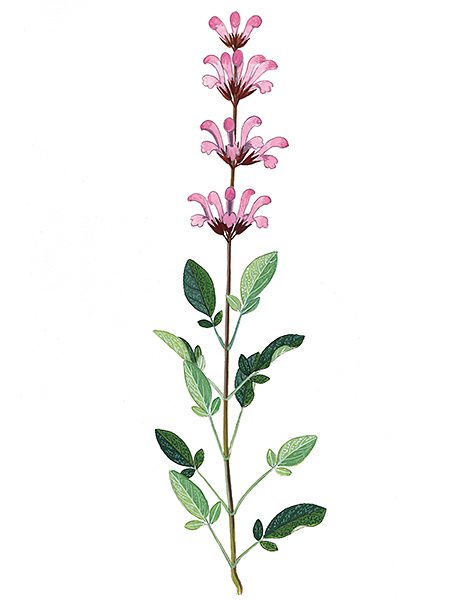
© Illustration: George Sfikas
Spearmint
Mentha spicata
Along with its close relative peppermint, this herb is abundant both in nature and in the gardens of Kos. Since antiquity, it has enjoyed the reputation of a powerful healing plant. For Hippocrates, it has warming qualities, as well as diuretic and antiemetic powers, while he also uses it for fumigations and in vaginal suppositories for cleansing the womb. Spearmint tea is still consumed in the islands and mainland Greece, usually following a meal to aid digestion. Many are also aware of its use as a diuretic and a diaphoretic (for inducing sweat), for treating headaches and for calming the nerves.
Greek Sage
Salvia fruticosa
A perennial low shrub, sage prefers rocky and dry soils. Hippocrates mentions it as an astringent and a blood coagulant. He recommends using it as a compress or internally for inflammation, fever, lung diseases and as a lactation aid (it has been shown, however, to have precisely the opposite effect). It remains one of the most popular herbs among Greeks, who consume it in the form of tea to boost circulation, aid digestion and combat excessive sweating. As a mouthwash, it is effective against mouth infections, laryngitis and tonsillitis.












